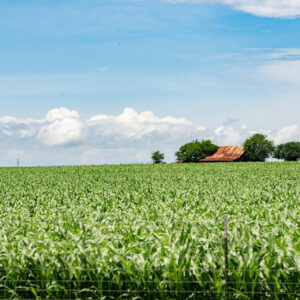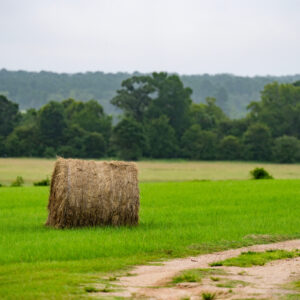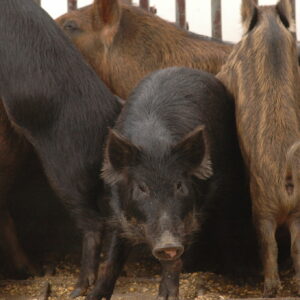Hydrilla verticillata (L.f.) Royle
[Hydrocharitaceae]
Hydrilla is a submersed plant with long slender stems. Hydrilla’s leaves are small and grow in whorls of 4 to 8 around the stem. Leaves are small, linear, and pointed with serrate edges. Hydrilla produces small white flowers on the stalks.
Hydrilla is capable of growing in virtually any water body, including lakes, streams, ponds, and canals. While it generally grows submerged, it often forms dense mats at the surface which are very detrimental to the ecosystem. The plant reproduces by stem fragments carried by people or boats. Seeds and capsules can also disperse through water or be carried by animals. Due to these highly specialized growth habits, hydrilla has spread rapidly along the coastal United States.
Hydrilla provides habitat for black bass and forage fish so sport fishermen appreciate the plant. However, in high densities the plant can interfere with navigation. Consequently, it is a challenge to manage this plant in a way to satisfy all demands.
Hydrilla verticillata is a plant native to the warmer parts of Asia. Hydrilla first appeared in the United States in Florida in 1960. Since then hydrilla has spread west as far as California and north as far as Delaware. Due to its rapid spread throughout the United States, has become a serious problem weed. The plant is capable of displacing native plants, impacting water quality, and interfering with various water usages, both economical and recreational.
Foreign exploration for insects as biological control agents were conducted by Balciunas (1982, 1983, 1984, 1985) and Balciunas and Dray (1985). Five candidate species were investigated in subsequent quarantine studies (Balciunas 1987; Balciunas and Center 1988; and Balciunas, Center, and Dray 1989). The species that have been released in the U. S. are: hydrilla tuber weevil, Bagous affinis; and two hydrilla leaf-mining flies, Hydrellia balciunasi and Hydrellia pakistanae (Buckingham 1990; Center et al. 1991).
- Grass Carp, Ctenopharyngodon idella
- Hydrilla tuber weevil, Bagous affinis
- Hydrilla leafmining fly, Hydrellia pakistanae
- Hydrilla leafmining fly, Hydrellia balciunasi Bock
Buckingham, G. R. 1988. Reunion in Florida – Hydrilla, a weevil, and a fly. Aquatics 10(1): 19-25, illus.
Balciunas, J. K. 1982. Overseas searches for insects for control of aquatic plants. Pages 141-145 in Proceedings, 16th Annual Aquatic Plant Control Research Program and Operations Review. Miscellaneous Paper A-82-3. US Army Engineer Waterways Experiment Station. Vicksburg, MS.
Balciunas, J. K. 1983. Overseas searches for insects on hydrilla in Southeast Asia and Australia. Pages 104-114 in Proceedings, 17th Annual Aquatic Plant Control Research Program and Operations Review. Miscellaneous Paper A-83-9. US Army Engineer Waterways Experiment Station. Vicksburg, MS.
Balciunas, J. K. 1984. Overseas searches of biocontrol agents for hydrilla. Pages 76-84 in Proceedings, 18th Annual Aquatic Plant Control Research Program and Operations Review. Miscellaneous Paper A-84-4. US Army Engineer Waterways Experiment Station. Vicksburg, MS.
Balciunas, J. K. 1985. Final report on overseas surveys (1981-1983) for insects to control hydrilla. Technical Report A-85-4. US Army Engineer Waterways Experiment Station. Vicksburg, MS.
Balciunas, J. K. 1987. Australian insects to control hydrilla. Pages 57-66 in Proceedings, 21th Annual Aquatic Plant Control Research Program and Operations Review. Miscellaneous Paper A-87-2. US Army Engineer Waterways Experiment Station. Vicksburg, MS.
Balciunas, J. K., and F. A. Dray. 1985. The search for insects to control U. S. hydrilla populations. Pages 75-78 in Proceedings, 19th Annual Aquatic Plant Control Research Program and Operations Review. Miscellaneous Paper A-85-4. US Army Engineer Waterways Experiment Station. Vicksburg, MS.
Balciunas, J. K., and T. D. Center. 1988. Australian insects to control hydrilla, an update. Pages 312-319 in Proceedings, 22th Annual Aquatic Plant Control Research Program and Operations Review. Miscellaneous Paper A-88-5. US Army Engineer Waterways Experiment Station. Vicksburg, MS.
Balciunas, J. K., T. D. Center, and F. A. Dray, Jr. 1989. Testing suitability of Australian bioagents for control of Hydrilla verticillata. Pages 24-27 in Proceedings, 23th Annual Aquatic Plant Control Research Program and Operations Review. Miscellaneous Paper A-89-1. US Army Engineer Waterways Experiment Station. Vicksburg, MS.
Buckingham, G. R. 1990. Quarantine work – Insect biocontrol for hydrilla. Pages 28-33 in Proceedings, 23th Annual Aquatic Plant Control Research Program and Operations Review. Miscellaneous Paper A-89-1. US Army Engineer Waterways Experiment Station. Vicksburg, MS.
Center, T. D., F. A. Dray, Jr., and W. C. Durden. 1991. Release and Establishment of Insect Biocontrol Agents for Hydrilla Control. Waterways Experiment Station, MP A-91-3.
Westbrook, R. 1998. Invasive plants, changing the landscape of America: Fact book. Federal Interagency Committee for the Management of Noxious and Exotic Weeds (FICMNEW), Washington, D. C. 109 pp.





